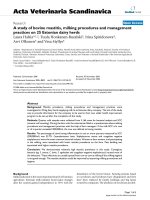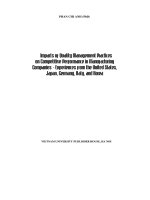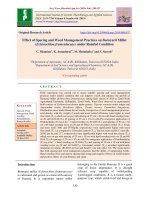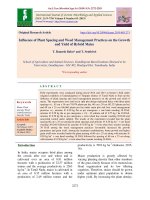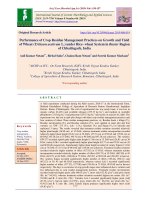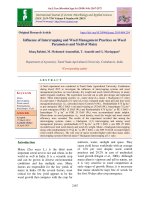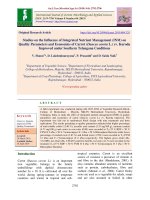Influences of spacing and weed management practices on growth parameters and weed dynamics of wet direct seeded rice
Bạn đang xem bản rút gọn của tài liệu. Xem và tải ngay bản đầy đủ của tài liệu tại đây (171.07 KB, 7 trang )
Int.J.Curr.Microbiol.App.Sci (2017) 6(6): 3044-3050
International Journal of Current Microbiology and Applied Sciences
ISSN: 2319-7706 Volume 6 Number 6 (2017) pp. 3044-3050
Journal homepage:
Original Research Article
/>
Influences of Spacing and Weed Management Practices on Growth
Parameters and Weed Dynamics of Wet Direct Seeded Rice
Bhujendra Kumar1*, H.L. Sonboir1, Saurabh Kumar1 and S. Singh2
1
Department of Agronomy, College of Agriculture, Indira Gandhi Krishi Vishwavidyalaya,
Raipur, 492012, (C.G.), India
2
Department of Plant Pathology, S.K. College of Agriculture and Research Station (Indira
Gandhi Krishi Vishwavidyalaya, Raipur), Kawardha - 491995, (C.G.), India
*Corresponding author
ABSTRACT
Keywords
Weed management,
Growth parameters,
Weeding and
Dynamics.
Article Info
Accepted:
29 May 2017
Available Online:
10 June 2017
At spacing 20×10 cm bidirectional mechanical weeding thrice (T4)
recorded the highest plant height. No of tillers, dry matter productions,
grain yield and the lowest weed density and dry matter accumulation of
weeds at all the stages of crop growth. At spacing 20×20 cm bidirectional
mechanical weeding thrice (T10) observed the highest plant height, No of
tillers, dry matter productions, grain yield and the lowest weed density and
dry matter accumulation. Among the spacing 20×10 cm and 20×20 cm at
spacing 20×20 cm bidirectional mechanical weeding thrice (T10) recorded
the plant height, No of tillers, dry matter productions, grain yield and the
lowest weed density and dry matter accumulation of weed which was at par
with bidirectional mechanical weeding thrice (T9) most of the growth stages
of rice.
Introduction
Rice (Oryza sativa L.) is one of the world's
most important stable food crops. Currently,
more than one third of the human population
relies on rice for their daily sustenance
(Chauhan and Johnson, 2011). Rice is the
vital food for more than two billion people in
Asia and four hundred million people in
Africa and Latin America (IRRI, 2006). It is
primary source of income and employment
for more than 100 million households in Asia
and Africa (FAO, 2004) World demand
projected to increase by 25% from 2001 to
2025 to keep pace with population growth
(Maclean et al., 2002). In world, rice has
occupied an area of 156.1 m ha, with a
production of 680 m t. In India, total area
under rice was 45.5 m ha, with production of
106.65 m t and average productivity of 2419
kg ha-1during 2013-14 (Anonymous, 2014).
Chhattisgarh state is popularly known as
“Rice Bowl of India” because of maximum
area covered under rice during kharif and
contributes major share in national rice
production. Rice was cultivated over an area
of 3.7 m ha with the production of 7.44 m t
and productivity of 2020 kg ha-1 during 2013-
3044
Int.J.Curr.Microbiol.App.Sci (2017) 6(6): 3044-3050
14 (Anonymous, 2015). Weed is as old as
agriculture and from the very beginning
farmers realized the interferences of weed
with crop productivity (Ghersa et al., 2000).
The risk of yield loss from weeds in directseeded rice is greater than transplanted rice
(Rao et al., 2007), damage to the rice seedling
and mistake removal of rice seedlings
(Moody and cordova, 1985). The labour
requirement for transplanting is very high and
also for a short period of the time. Further, the
availability of labour is decreasing day by day
due to various reasons. Therefore, an alternate
technology to substitute transplanting method
is needed to gear up rice production in
irrigated ecology. One of the alternate
technology may be wet direct seeded method.
Therefore, the study was conducted to
evaluate effect of wet direct seeded rice on
growth parameters, no of tillers and dry
matter production of rice and weed density
and dry matter accumulation of weeds.
Materials and Methods
The present investigation was conducted
during kharif season of 2014-15 at the
Research cum Instructional Farm, Indira
Gandhi Krishi Vishwavidyalaya, Raipur
(C.G.). The soil of experimental field was
vertisol in texture, low in nitrogen (223.30 kg
ha-1), medium in phosphorus (17.40 kg ha-1)
and medium in potassium (272.80 kg ha-1)
contents with neutral soil pH and 0.51 per
cent organic carbon.
The experiment was laid out in randomized
block design comprises of eleven treatments
with three replications. The treatments
comprised spacing and weed management
practices viz, T1 – Direct Seeded 20×10 cm +
hand weeding twice at 20 and 40 DAS, T2 Direct Seeded 20×10 cm + herbicidal weed
management (Pre. eme. Pyrazosulfuron f.b.
Bispyribac-Na), T3 - Direct Seeded 20×10 cm
+ mechanical weeding unidirectional twice at
20 and 40 DAS, T4 - Direct Seeded 20×10 cm
+ mechanical weeding unidirectional thrice at
20, 30 and 40 DAS, T5 - Direct Seeded 20×20
cm + hand weeding twice at 20 and 40 DAS,
T6 - Direct Seeded 20×20 cm + herbicidal
weed management (Pre. eme. Pyrazosulfuron
followed by Bispyribac-Na), T7 - Direct
Seeded 20×20 cm + mechanical weeding
unidirectional twice at 20 and 40 DAS, T8 Direct Seeded 20×20 cm + mechanical
weeding unidirectional thrice at 20, 30 and 40
DAS, T9 - Direct Seeded 20×20 cm +
mechanical weeding bidirectional twice at 20
and 40 DAS, T10 - Direct Seeded 20X20 cm +
mechanical weeding bidirectional thrice at 20,
30 and 40 DAS, T11 – Transplanting 20X10
cm + herbicidal weed management (Pre. eme.
Pyrazosulfuron followed by Bispyribac-Na).
The test variety was maheshwari. Sowing of
sprouted seeds was done in puddle soil.
Sowing was done on June 29, 2014 and
harvesting was done on November 10, 2014.
Recommended dose of nutrients (100 kg N:
60 kg P2O5: 40 kg K2O ha-1) was applied
through urea, single super phosphate and
murate of potash, respectively.
The whole quantity of P and K was applied as
basal dressing, while nitrogen was applied in
three equal splits at basal, active tillering and
panicle initiation stages. 3±2 cm level of
water was managed after established of crop
till growth stage. Among the treatments when
herbicidal weed management was adopted,
applied of pre emergence of pyrazosulfuron at
3 days after sowing followed by bispyribacNa at 25 days after sowing was done. All the
growth characters viz. plant height, number of
tillers m-2, dry matter production, dry matter
accumulation of weed, weed density, nutrient
uptake by weeds and grain yield of wet direct
seeded rice were recorded. The total weed
density and total dry matter accumulation
weeds were also recorded and subjected to
square root
transformation and
statistically analyzed.
3045
Int.J.Curr.Microbiol.App.Sci (2017) 6(6): 3044-3050
Results and Discussion
Effect on Plant height
The result reveals that the plant height of rice
was significantly influenced by spacing and
weed management practices are presented in
table 1. At spacing 20×10 cm, mechanical
weeding thrice (T4) observed the highest plant
height (125.00 cm) which was at par with
mechanical weeding twice, hand weeding
twice and transplanting with herbicidal weed
management. At spacing 20×20 cm,
bidirectional mechanical weeding thrice (T10)
recorded the highest plant height (128.73 cm).
The lowest plant height (123.17 cm) was
observed under herbicidal weed management
(T6). Among the spacing 20×10 cm and
20×20 cm, the effect of weed management
practices on plant height was at par with the
respective level of weed management.
The possible reason of the maximum plant
height in these treatments might be due to
favourable and weed free environment during
crop growth period which provided better
opportunity for overall growth and
development of rice plants lead to increased
plant height.
Maximum plant height noted under
bidirectional mechanical weeding thrice (T10)
may be due to incorporation of weeds in soil
which improve the soil aeration and enhance
the additional nutrient uptake by crop. Similar
result was also reported by (Rajendran et al.,
2007).
Effect on number of tillers m-2
At spacing 20×10 cm, mechanical weeding
thrice (T4) recorded the highest number of
tillers (341.33 m-2) which was at par with
(T3), (T11) and (T1). The lowest number of
tillers (327 m-2) was noted under herbicidal
weed management (T2). At spacing 20×20
cm, bidirectional mechanical weeding thrice
(T10) observed the highest number of tillers
(366 m-2) which was at par with bidirectional
mechanical weeding twice (T9). The lowest
number of tillers (331 m-2) was found under
herbicidal weed management (T6). Among the
spacing 20×10 cm and 20×20 cm, number of
tillers was at par with the respective level of
weed management.
The result exhibited that maximum number of
tillers per unit area was recorded with
mechanical weeding twice or thrice which
may be due to aeration of field due to
mechanical operation. Similarly with respect
to spacing, maximum number of total tillers
was recorded in wider spacing (20x20 cm)
compared to closer spacing (20x10 cm) which
may be due to more space to crop to show
their potential due to the lower weed
competition in term of dry matter of weeds,
which allow crop to absorb required amount
of nutrient, water and sunlight for their
growth and tillering behavior. Similar results
were reported by different workers (Shad
1986, Thiyagarajan et al., 2002)
Effect on dry matter production of rice
At spacing 20X10 cm, mechanical weeding
thrice (T4) noted the highest dry matter
accumulation (950.27 g m-2) which was at par
with transplanting with herbicidal weed
management (T11), mechanical weeding
twice (T3) and hand weeding twice (T1). At
spacing 20×20 cm, bidirectional mechanical
weeding thrice (T10) found the highest dry
matter accumulation (1036.63 g m-2) which
was at par with bidirectional mechanical
weeding twice (T9). Among the spacing
20×10 cm and 20×20 cm, the effect of weed
management practices on dry matter
accumulation was at par with the respective
level of weed management.
3046
Int.J.Curr.Microbiol.App.Sci (2017) 6(6): 3044-3050
Table.1 Influences of Spacing and weed management practices on growth parameter of wet direct seeded rice
Growth parameters of Rice
Treatments
Grain yield
q ha-1
DMP (g m-2)
at harvest
907.27
43.12
T1
DS 20X10 HW at 20 & 40 DAS
124.37
Number of
tillers m-2
at harvest
336.67
T2
DS 20X10 HWM
122.63
327.00
888.83
41.32
T3
DS 20X10 MWM at 20 & 40 DAS
124.90
340.00
915.47
43.18
T4
DS 20X10 MWM at 20, 30 & 40 DAS
125.00
341.33
950.27
44.25
T5
DS 20X20 HW at 20 & 40 DAS
124.47
340.67
924.00
43.40
T6
DS 20X20 HWM
123.17
331.00
902.23
42.64
T7
DS 20X20 MWM at 20 & 40 DAS uni.
125.27
345.00
934.47
43.58
T8
DS 20X20 MWM at 20, 30 & 40 DAS uni.
126.07
349.33
961.30
44.86
T9
DS 20X20 MWM at 20 & 40 DAS bi.
126.57
359.67
1014.57
48.02
T10
DS 20X20 MWM at 20, 30 & 40 DAS bi.
127.27
366.00
1036.63
49.12
T11
TP 20X10 HWM
124.10
338.67
926.23
43.43
0.91
4.92
14.65
0.78
2.70
14.51
43.21
2.31
SEm ±
CD (P=0.05)
Plant height (cm)
at harvest
Figures in the parentheses are original value, data were transformed through √ x+0.5 which are given in bold.
DS=Direct seeded: HW= Hand weeding: MWM= Mechanical weed management: HWM= Herbicidal weed management: DAS= Days after sowing: TP=
Transplanting: uni= Unidirectional: bi= Bidirectional, DMP= Dry matter production.
*Significant at 5% level of significance
3047
Int.J.Curr.Microbiol.App.Sci (2017) 6(6): 3044-3050
Table.2 Effect of Spacing and weed management practices on Weed density (No. m-2) and
Dry matter accumulation of weed (g m-2) of wet direct seeded rice
Weed density (No. m-2)
Treatments
30 DAS
T1
DS 20X10 cm HW at 20 & 40 DAS
2.90 (8.0)
T2
DS 20X10 cm HWM
2.41 (5.3)
T3
DS 20X10 cm MWM at 20 & 40 DAS
T4
T5
DS 20X10 cm MWM at 20, 30 & 40
DAS
DS 20X20 cm HW at 20 & 40 DAS
3.32
(10.7)
3.23
(10.0)
2.90 (8.0)
T6
DS 20X20 cm HWM
2.53 (6.0)
T7
DS 20X20 cm MWM at 20 & 40 DAS
uni.
DS 20X20 cm MWM at 20, 30 & 40
DAS uni.
DS 20X20 cm MWM at 20 & 40 DAS
bi.
DS 20X20 cm MWM at 20, 30 & 40
DAS bi.
TP 20X10 cm HWM
3.23
(10.0)
3.12 (9.3)
T8
T9
T10
T11
SEm ±
CD (P=0.05)
2.53 (6.0)
2.41 (5.3)
0.71 (0.0)
0.07
0.20
60 DAS
2.67
(6.7)
2.79 (
7.3)
3.23
(10.0)
3.12
(9.3)
2.67
(6.7)
2.79
(7.3)
3.11
(9.3)
3.02
(8.7)
2.08
(4.0)
1.94
(3.3)
2.79
(7.3)
0.19
0.55
90 DAS
2.79
(7.3)
3.02
(8.7)
3.23 (10.0)
3.02
(8.7)
2.53
(6.0)
2.79
(7.3)
3.11
(9.3)
2.90
(8.0)
2.41
(5.3)
2.26
(4.7)
2.90
(8.0)
0.18
0.55
at
harvest
2.53
(6.0)
2.53
(6.0)
3.02
(8.7)
2.90
(8.0)
2.26
(4.7)
2.41
(5.3)
2.79
(7.3)
2.53
(6.0)
2.08
(4.0)
1.94
(3.3)
2.53
(6.0)
0.19
0.55
Dry matter accumulation of weed
(g m-2)
30 DAS
60 DAS
90 DAS
at
harvest
0.88
2.13
3.19
2.34
(0.27)
(4.06)
(9.73)
(4.97)
0.81
2.65
3.39
2.51
(0.16)
(6.55)
(10.99)
(5.81)
1.83
2.97
3.67
2.73
(2.88)
(8.33)
(13.00)
(6.99)
1.78
2.75
3.44
2.52
(2.68)
(7.07)
(11.35)
(5.85)
1.01
2.01
3.28
2.34
(0.55)
(3.57)
(10.33)
(5.02)
0.84
2.68
3.29
2.49
(0.21)
(6.68)
(10.31)
(5.73)
1.79
2.89
3.37
2.69
(2.71)
(7.85)
(10.83)
(6.72)
1.74
2.63
3.28
2.51
(2.55)
(6.43)
(10.25)
(5.81)
1.42
2.21
2.70
2.10
(1.51)
(4.40)
(6.81)
(3.91)
1.44
1.98
2.50
2.09
(1.58)
(3.49)
(5.75)
(3.81)
0.71
2.66
3.38
2.64
(0.00)
(6.57)
(11.01)
(6.51)
0.07
0.08
0.13
0.08
0.20
0.25
0.39
0.24
Figures in the parentheses are original value, data were transformed through √ x+0.5 which are given in bold
DS=Direct seeded: HW= Hand weeding: MWM= Mechanical weed management: HWM= Herbicidal weed management: DAS= Days after sowing: TP=
Transplanting: uni= Unidirectional: bi= Bidirectional
*Significant at 5% level of significance
3048
Int.J.Curr.Microbiol.App.Sci (2017) 6(6): 3044-3050
In general, all the treatments where
herbicides, cultural and mechanical methods
applied to control weeds and accumulated of
dry matter of rice was the effect of weed
management on weeds so rice plant received
more space, moisture, light and nutrient for
their proper growth the higher dry matter
accumulation of rice. The possible reason of
higher accumulation and this favoured the
higher dry matter accumulation of rice per
unit area.
Effect on weed dynamics
The result reveals that the weed density (no.
m-2) was significantly influenced by spacing
and weed management practices are presented
in table 2. At 20 DAS, only Echinochloa
colona was the observed weed flora which
population decreased with advancement of
crop period. Cyperus iria was appeared at 40
DAS and its population was increased with
the advancement of crop period. Broad leaved
weeds were not found in experiment field
throughout the crop period.
At spacing 20X10 cm, hand weeding twice
(T1) recorded the lowest weed density m-2
which was at par with herbicidal weed
management and transplanting with herbicidal
weed management at 30, 60, 90 DAS and at
harvest. At spacing 20X20 cm, bidirectional
mechanical weeding thrice (T10) found the
lowest weed density m-2 which was at par
with bidirectional mechanical weeding twice
and herbicidal weed management at 30, 60,
90 DAS and at harvest. Among the spacing
20X10 cm and 20X20 cm, the weed density
m-2 was at par with respective level of weed
management at 30, 60, 90 DAS and at
harvest.
Effect on dry matter accumulation of
weeds
The dry matter production of weeds decreased
due to use of different weed management
practices are presented in table 2. At spacing
20X10 cm, the lowest dry matter production
of weeds was registered under hand weeding
twice (T1) which was at par with herbicidal
weed management and transplanting with
herbicidal weed management at 30, 60, 90
DAS and at harvest. At spacing 20X20 cm,
bidirectional mechanical weeding thrice (T10)
found the minimum dry matter production of
weeds which was at par with bidirectional
mechanical weeding thrice at 30, 60, 90 DAS
and at harvest. Among 20X10 cm and 20X20
cm, the dry matter production of weeds m-2
was at par with respective level of weed
management. Dry matters of weeds were
incorporated in the field by mechanical
weeding which enhances the organic matter
and properties of the soil.
Effect on yield
The result reveals that the grain yield of rice
was significantly influenced by spacing and
weed management practices are presented in
table 1. At spacing 20×10 cm, mechanical
weeding thrice (T4) produced the highest
grain yield (44.25 q ha-1) which was at par
with mechanical weeding twice (T3), hand
weeding twice (T1) and transplanting with
herbicidal weed management (T11). At
spacing 20×20 cm, bidirectional mechanical
weeding thrice (T10) produced significantly
the highest grain yield (49.12 q ha-1) which
was at par with bidirectional mechanical
weeding twice (T9). Among the spacing
20×10 cm and 20×20 cm, the effect of weed
management practices on grain yield was at
par with the respective level of weed
management.
Grain production, which is the final product
of growth and development, is controlled by
the growth and yield attributing characters
such as effective tillers, dry matter
accumulation, test weight, etc. Growth and all
yield attributing characters were more in
bidirectional mechanical weeding thrice (T10)
3049
Int.J.Curr.Microbiol.App.Sci (2017) 6(6): 3044-3050
because of lesser weed competition and better
aeration which enhances better uptake of
nutrients through enhanced root growth. The
beneficial effect of mechanical weeding in
rice production by System of rice
intensification is attributed by different
workers (Vijayakumar et al., 2004 and
Rajendran et al., 2007).
References
Anonymous, 2014. Ministry of Agriculture,
Government
of
India.
www.
Indiastat.co.in/ agriculture/agriculture
production/grains/rice.
Anonymous, 2015. Krishi Darshika, Indira
Gandhi
Krishi
Vishwavidyalaya,
Raipur, (C.G.) pp. 4.
Chauhan, B.S. and Johnson, D.E., 2011.
Growth response of direct seeded rice to
oxadiazon and bispyribac-sodium in
aerobic and saturated soils. Weed
Science. 59:199-122.
FAO (Food and Agriculture Organization of
the United Nations) 2004. Rice and us.
Ghersa, C.M., Benech-Arnold, R.L., Satorre,
E.H. and Martinez-Ghersa, M.A., 2000.
Advances in weed management
strategies. Field Crop Research. 67:95104.
IRRI (International Rice Research Institute),
2006.
World
Rice
Statistics.
http;//www.irri.org/science/wrs.
Maclean, J.L., Dawe, D.C. Hardy, B. and
Hettel, G.P., 2002. Rice Almanac. Los
Banos (Philippines): International Rice
Research Institute, Bouake` (Cote
d’lvoire):
West
Africa
Rice
Development
Association,
Cali
(Colombia)
Moody, K. and Corvoda, V.G., 1985. WetSeeded rice. In women in rice farming.
International Rice Research Insti tute,
los Banos, Phikippines, p. 467-480.
Rajendran,
R.,
Ravi,
V.
and
Balsubramaniyam, V., 2007. Individual
and combined effect of management
components of SRI on the productivity
of irrigated rice. In: proc. SRI India
2007 Sym. Tripura, pp. 76-78.
Rao, A.N., Johnson, D.E., Sivaprasad, B.,
Ladha, J.K. and Mortimer, A.M., 2007.
Weed management in direct seeded rice.
Advanced Agronomy. 93:153-155.
Shad R A. 1986. Improving weed
management
in
wetland
rice.
Progressive Farming 6:49-53.
Thiyagarajan, T.M, Senthil, K., Bindraban,
P.S., Hengsdijk. H, and Ramaswamy, S.
2002. Crop management options for
increasing water productivity in rice.
Journal of Agricultural Resource and
Management, 34: 169-181.
Vijaykumar M., Singh S.D.S., Prabhakaran,
N.K. and Thiyagarajan, T.M. 2004.
Effect of SRI practices on yield
attributes, yield and water productivity
of rice (Oryza sativa L.). Indian Journal
of Agronomy, 52: 399-408.
How to cite this article:
Bhujendra Kumar, H.L. Sonboir, Saurabh Kumar and Singh, S. 2017. Influences of Spacing
and Weed Management Practices on Growth Parameters and Weed Dynamics of Wet Direct
Seeded Rice. Int.J.Curr.Microbiol.App.Sci. 6(6): 3044-3050.
doi: />
3050
